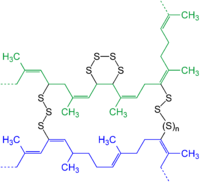
Photo from wikipedia
Previous studies have shown the benefits of the amine-reactive, CID-MS/MS-cleavable cross-linker disuccinimidyl dibutyric urea (DSBU) for structural proteomics studies via cross-linking/MS (XL-MS). To further facilitate the automation of XL-MS experiments,… Click to show full abstract
Previous studies have shown the benefits of the amine-reactive, CID-MS/MS-cleavable cross-linker disuccinimidyl dibutyric urea (DSBU) for structural proteomics studies via cross-linking/MS (XL-MS). To further facilitate the automation of XL-MS experiments, we synthesized a deuterated (D12) version of the DSBU cross-linker combining the advantages of MS-cleavable linkers and isotope labeling. The rationale of conducting XL-MS with a mixture of unlabeled and stable isotope-labeled DSBU is to obtain characteristic mass differences at the MS level indicating cross-linked species. These cross-linked species can then be selected for fragmentation by collisional activation. At the MS/MS level, the characteristic 26-u doublets arising from cleavage of the central urea group in DSBU confirm the amino acid sequences of cross-linked peptides as well as the exact cross-linking sites. D12-labeled DSBU was tested on three systems with increasing complexity: (i) bovine serum albumin as purified protein, (ii) Escherichia coli ribosome as large, multimeric protein assembly, and (iii) Drosophila embryo extract as complete proteome. We demonstrate the benefits arising from the use of isotope-labeled DSBU for an automated assignment of cross-linked products. Combining isotope labeling and MS cleavability in one cross-linker resulted in higher cross-link identification numbers especially for highly complex protein mixtures.
Journal Title: Journal of the American Society for Mass Spectrometry
Year Published: 2020
Link to full text (if available)
Share on Social Media: Sign Up to like & get
recommendations!